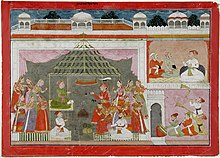Mandavi

| Mandavi | |
|---|---|
 The wedding ceremony of Mandavi and Bharata. | |
| Affiliation | Avatar of Lakshmi's conch shell |
| Abode | Ayodhya, Vaikunth |
| Texts | Ramayana and its other versions |
| Personal information | |
| Born | |
| Died | |
| Parents | Kushadhvaja (father) Chandrabhaga (mother) |
| Siblings | Sita (adoptive cousin) Urmila (cousin) Shrutakirti (sister) |
| Spouse | Bharata |
| Children | Taksha Pushkala |
| Dynasty | Videha (by birth) Raghuvamsha-Suryavamsha (by marriage) |
Mandavi (Sanskrit: माण्डवी, romanized: Māṇḍavī) is a princess in the Hindu epic Ramayana.[1] She is the wife of Bharata and is considered to be an incarnation of the conch shell of goddess Lakshmi. Mandavi is known for her sacrifice and perseverance.[2][3]
Etymology[edit]
The name Mandavi is of Sanskrit origin. Her name means 'fit and competent'.[4]
Legend[edit]
Birth and early life[edit]
Sunayana and Chandrabhaga, the wives of Janaka and Kushadhvaja, gave birth to Urmila and Mandavi. Chandrabhaga later gave birth to her second daughter and Mandavi's younger sister, Shrutakirti.[5] She is considered as the incarnation of Lakshmi's conch shell.[6] Her father was the ruler of Samkasya, but Mandavi and Shrutakirti were brought up in Mithila, along with Sita and Urmila.[7]
Marriage to Bharata[edit]
After Rama won the hand of Sita at her svayamvara, his father, King Dasharatha arrived in Mithila for his son's wedding. He noticed that Lakshmana had feelings for Urmila, King Janaka's younger daughter, but according to tradition, Bharata and Mandavi had to marry first. King Dasharatha arranged for Bharata to marry Mandavi and for Shatrughna to marry Shrutakirti, allowing Lakshmana to marry Urmila. Ultimately, all four sisters married the four brothers, strengthening the alliance between the kingdoms.[8] The wedding ceremony was conducted under the guidance of Shatananda.[9]
Mandavi and Bharata had two sons named Taksha and Pushkala. While, Taksha founded the city of Taksha-sila, to the east of Indus, Pushkala founded Pushkala-vati, to the west of the Indus.[10]
Bharata's exile[edit]
When her mother-in-law Kaikeyi, compelled Dasharatha to make Bharata king and forced Rama to leave Ayodhya and spend a period of exile. Sita and Lakshmana willingly renounced the comforts of the palace and joined Rama in exile. Bharata decided to lead a life in exile at Nandigram, till the completion of Rama's exile. On his request, Mandavi stayed back in Ayodhya to look after her husband's aging parents.[11][12] Mandavi then decided to not meet her husband for those fourteen years, so that he could devotee his time for the welfare of Ayodhya and fulfill his brother's responsibilities.[13]
Death[edit]
According to a legend in Tulsidas's Ramcharitmanas, Mandvi along with her sister Shrutakirti, became Sati with her husband, and died after her husband's samadhi. While, Urmila stayed in Ayodhya to look after her son's Angada and Chandraketu, and Sita's sons Lava and Kusha[14]
Worship[edit]
In the Medak district of Telangana, there is a temple called Sri Kalyana Ramachandra Sannadhi that is dedicated to Bharata and Mandavi. This temple is the only one in India that has installed statues of Rama's brothers and their wives.[15][16]
In popular culture[edit]
- Portrayed by Sulakshana Khatri in 1987–1988 Indian epic drama Ramayan[17]
- Portrayed by Raji Sharma in 1997-2000 Indian epic drama Jai Hanuman
- Portrayed by Rajni Chandra in 2002 Indian epic drama Ramayan
- Portrayed by Prithvi Hatte in 2015–2016 Indian epic drama Siya Ke Ram[18]
- Portrayed by Richa Dixit in 2019–2020 Indian epic drama Ram Siya Ke Luv Kush
- Portrayed by Sheersha Tiwari in 2024 Indian epic drama Shrimad Ramayan
References[edit]
- ^ Dawar, Sonalini Chaudhry (2006). Ramayana, the Sacred Epic of Gods and Demons. Om Books International. ISBN 9788187107675.
- ^ Agarwal, Shubhi (20 April 2022). LakshmiLa : The Eternal Love Story. Om Books International. ISBN 978-93-92834-21-9.
- ^ Valmiki Ramayana, English verse translation by Desiraju Hanumanta Rao, K. M. K. Murthy et al.
- ^ www.wisdomlib.org (21 September 2015). "Mandavi, Māṇḍavī: 9 definitions". www.wisdomlib.org. Retrieved 3 August 2022.
- ^ Praśānta Guptā (1998). Vālmīkī Rāmāyaṇa. Dreamland Publications. p. 32. ISBN 9788173012549.
- ^ "Sita's Sisters: Conversations On Sisterhood Between Women Of Ramayana". Outlook India. Retrieved 26 October 2023.
- ^ "Ramayana | Summary, Characters, & Facts". Encyclopedia Britannica. Archived from the original on 12 April 2020. Retrieved 18 February 2020.
- ^ Debroy, Bibek (2005). The History of Puranas. Bharatiya Kala Prakashan. ISBN 978-81-8090-062-4.
- ^ Valmiki. The Ramayana. pp. 126–145.
- ^ "The Ramayana and Mahabharata: Conclusion". www.sacred-texts.com. Retrieved 7 August 2020.
- ^ "Ramayana: Check 13 lesser-known facts". Jagranjosh.com. 5 August 2020. Retrieved 7 August 2020.
- ^ Moor, Edward (1810). The Hindu Pantheon. J. Johnson. p. 316.
- ^ Goldman, Robert P.; Goldman, Sally J. Sutherland (18 January 2022). The Rāmāyaṇa of Vālmīki: The Complete English Translation. Princeton University Press. p. 255. ISBN 978-0-691-20686-8.
- ^ MacFie, J. M. (1 May 2004). The Ramayan Of Tulsidas Or The Bible Of Northern India. Kessinger Publishing. ISBN 978-1-4179-1498-2.
- ^ "Sri Kalyana Ramachandra Swamy temple: Small wonder on a hillock". Deccan Chronicle. 3 December 2017.
- ^ "This unique Rama temple near Hyderabad where Hanuman finds no place". The News Minute. 17 April 2016.
- ^ "Ramayana cast and characters: A full list". www.timesnownews.com. 17 April 2020. Retrieved 7 August 2020.
- ^ "Mera naam Prithvi hai, aur main ek ladki hoon' - Times of India". The Times of India. 8 May 2017. Retrieved 7 August 2020.
